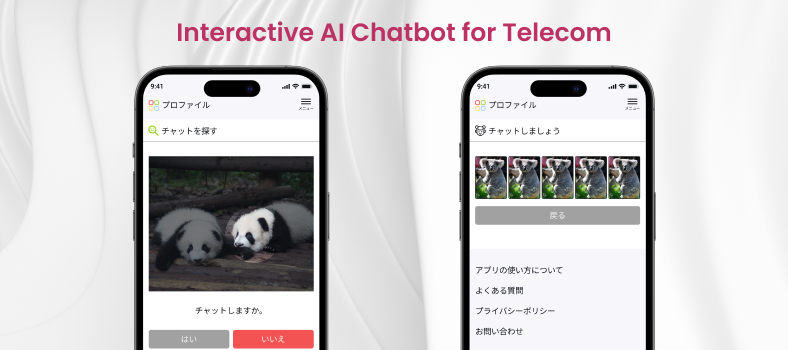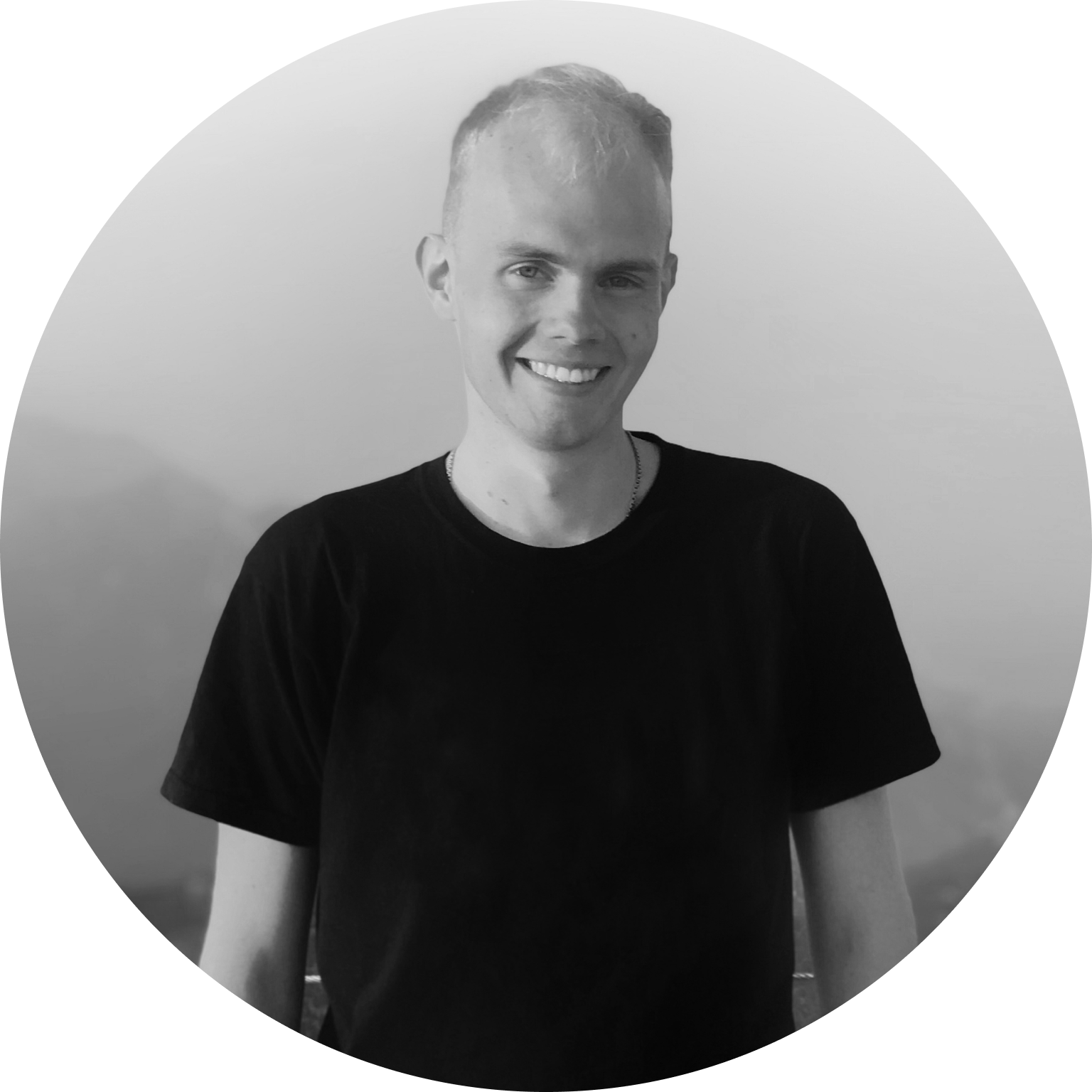Chatbots are rising! By 2027, one out of four businesses will employ them as a primary tool for customer service. It is easy to see why. Chatbots are always on the alert, able to manage multiple tasks at once. They are also efficient and friendly thanks to the latest innovations in generative AI.
But a crucial question arises: how secure are AI chatbots? Can you really trust them with customer data and your business reputation?
Let us explore what can compromise AI chatbot security and how you can ensure that your solution is both smart and reliable.
AI Chatbot for Telecom: Insights from a Real Project
Experience is the best teacher, so let us begin with our own case. During the COVID-19 pandemic, we started an exciting project for a Japanese telecom company. They wanted to make their customer service more engaging and asked us to develop a new mobile app.
The star of this application is an AI chatbot designed like a cute cartoon character. It is not just for business talks; it can also chit-chat and build friendly connections with users. Inspired by the fun of a Tamagotchi, the character always stays positive, learns new words, tells jokes, and can talk about anything. Plus, it gives users helpful tips and the latest news about the company’s services.

Of course, when users see a lovely creature that offers engaging communication, they do not think about security. Instead, they see the character as a part of the team they trust. So, our job as a generative AI consulting company was to create a seamless interaction and ensure top confidentiality in our AI chatbot.
Now, let us closely examine different aspects of AI chatbot security. We will discuss risks that might threaten our virtual assistant, practical solutions that help mitigate these issues, and testing activities to guarantee our solution is safe to use.
Chatbots and Trust: Top Challenges for AI Chatbot Security
Like many AI innovations, chatbot technology can face different security risks such as data exposure, phishing, or malicious code. All the risks are broadly classified into vulnerabilities and threats.
Vulnerabilities are weaknesses within a chatbot’s design due to weak coding, poor maintenance, insufficient security measures, or human errors.
Threats, in contrast, are external attacks that exploit an AI chatbot’s vulnerabilities. They can take various forms, including impersonation attacks on users, ransomware, phishing schemes, malware infiltration, whaling attacks, unauthorized access leading to data theft or alteration, hackers reusing chatbots for malicious purposes, etc.

Our engineers developed a plan of preventing data breaches in the AI chatbot system and regularly check our cute animated software solution for weaknesses.
Providing Security in AI Chatbots: A Comprehensive Checklist
Now, considering all these chatbot security risks, innovations might not seem as reliable as you thought, right? Fortunately, our team is experienced in AI chatbot development services and can provide necessary safety measures. For clarity, we have categorized all the security measures into five groups:
- encryption,
- authentication and authorization;
- safe protocols,
- education,
- new methods.
Let us take a closer look at each of them.

End-to-End Encryption
When a chat is encrypted, only the sender and receiver can access its content. End-to-end encryption stands out as the most effective method to maintain privacy in AI chatbots. We strongly recommend using it, particularly since encryption is vital to comply with data protection regulations in AI chatbot systems.
Strong Authentication and Authorization
Anonymous interactions with AI chatbots are unsafe. That’s why to gain access, we oblige our users to identify themselves. We combine the use of authentication and authorization as a defense strategy.
- Authentication is a confirmation of a user’s identity and associating it with a user ID.
- Authorization is a fancy word for granting access to anywhere, for example, your business system or our chatbot.
You can use a mix of options.
- User verification and access controls in AI chatbots
Initially, you can enhance security by verifying users before they access your chatbot. This is a common and widely accepted practice. Encouraging customers to create strong, unique passwords and keep them confidential is also important.
- Multi-factor authentication for AI chatbot access
This traditional security measure requires users to identify themselves with login credentials and additional methods like a code sent via email or phone.
Many people now access apps and devices using facial recognition or fingerprint scanning. AI chatbots can utilize these methods, too. You can go further and add voiceprints as an option and combine voice recognition with other authentication methods. It also provides a better customer experience since it works instantly, unlike other authentication methods.
This method is common for online banking and acts like a built-in security officer. If the system detects that logged-in users have not been active for a while, it automatically logs them out. Why? It is a great way to keep personally identifiable information safe, especially when customers use an AI chatbot or any other machine learning model on a shared computer. While it might be slightly inconvenient, it effectively prevents data breaches in AI chatbot systems.
AI Writes Back: Exploring the Benefits of Large Language Models for Your Business
Read more
Safe Protocols
HTTPS security protocols act like a high-security courier for online chats. It locks messages in a virtual safe using transport layer security (TLS) encryption and creates a secret code only the user and chatbot can decipher. Encrypted connections ensure information security.
Education
Surprisingly, the most common of all chatbot security risks is human error, not the software. Educating clients and employees can greatly enhance your solution’s security.
We recommend limiting access to a chatbot and regularly training employees on its secure usage. Make certain that new team members are educated on time and promptly revoke access from departing employees. This is vital for ensuring confidentiality in AI chatbots and securing both the system and user data from malicious use.
Create engaging educational newsletters, video tutorials, and concise instructions within the chatbot interface. The more users know about how AI chatbots work, the better equipped they are to recognize and avoid potential security issues provoked by user error.
Other Methods
New security technologies are expected to play a key role in protecting chatbots from future threats. The two most important are user behavior analytics and advanced AI tools.
- User behavior analytics (UBA)
UBA solutions watch and analyze how people use chatbots. They look for anything out of the ordinary that might be a sign of a problem, like someone trying to break in.
- AI-driven threat detection and response in chatbots
Artificial intelligence can quickly analyze huge amounts of data to find statistical irregularities caused by breaches from malicious actors or security threats toward sensitive data. As smart algorithms learn from different situations, they become better at protecting chatbots over time.
How to Test Your AI Chatbot Security
Continuous monitoring and auditing of AI chatbot security keeps your software healthy and reliable. Testing before launch and after updates is always a good idea. But what in particular should you check?

We recommend focusing on these measures:
- Penetration testing looks for potential vulnerabilities in your software and aims to hack an AI chatbot. This testing type is often called ‘ethical hacking’ or ‘friendly hacking’;
- API testing focuses on the backend part of your AI solution to find any weak spots there;
- UX testing allows specialists to check software from a user’s point of view. It is a good way to test security issues and determine how your AI chatbot communicates with users and how you can improve this interaction with time.
Final Words
AI chatbots are swiftly becoming an important tool for many businesses. But to the public eye, your chatbot is more than a tool; it is the face of your business and an integral part of your crew. Just as HR professionals care for your people, your chatbot requires a dedicated team to keep it smart and secure. So, choosing the right technical partner who deeply understands the technology and can proactively manage potential risks becomes essential.
This is where our Generative AI development company comes in to help. We have gathered a team of the finest minds in AI/ML and business strategy who are dedicated to crafting, testing, and launching the software solutions you need.
It is your play now! With us, you do not just get secure software; you are gaining a partner committed to bringing your innovative vision to life. Drop us a line, and let us start this journey together.
FAQs
-
Are AI chatbots secure?

AI chatbots can be highly secure when proper security measures are in place. This includes using encryption, strong authentication methods, secure protocols, education, and regular security audits. However, like any digital tool, AI chatbots are susceptible to risks if not properly managed and safeguarded.
-
What techniques are used to guarantee privacy in AI chatbots?

Maintaining privacy in AI chatbots involves multiple strategies. Key methods to mitigate security risks include end-to-end chat encryption, two-factor authentication and authorization procedures, regular security testing, and educating users about secure practices. More sophisticated approaches involve user behavior analytics and advanced AI-driven threat detection for chatbot systems.
-
Can CHI Software prevent data breaches in AI chatbot systems?

Engineers at CHI Software focus on implementing robust security measures in all our solutions to reduce the risk of data leaks, saving money of our clients in the process. While there is no such thing as fully secure systems, our approach includes regular security assessments. By employing the latest technologies and monitoring the AI chatbot, we can guarantee data privacy and security.
-
What role does secure authentication play for AI chatbot users?

Secure authentication is essential for user identity verification and blocking unauthorized entry. It involves multi-factor authentication, biometric verification, and authentication timeouts. These measures help make certain that only legitimate users are granted permission to interact with a chatbot. It protects both user data and chatbot services from malicious activities.
-
What defenses are effective against AI chatbot hacking attempts?

You should employ a combination of strategies to provide effective information security. A mix includes regular security audits and testing activities to identify vulnerabilities. Advanced encryption and safe protocols are used to protect data in transit. Robust authorization and authentication methods, including multi-factor authentication and biometric verification, help check user identities and prevent unauthorized access. Additionally, real-time user behavior monitoring and AI-driven threat detection identify and respond to any suspicious activities.
About the author
Alex Shatalov
Data Scientist & ML Engineer
Alex is a Data Scientist & ML Engineer with an NLP specialization. He is passionate about AI-related technologies, fond of science, and participated in many international scientific conferences.






